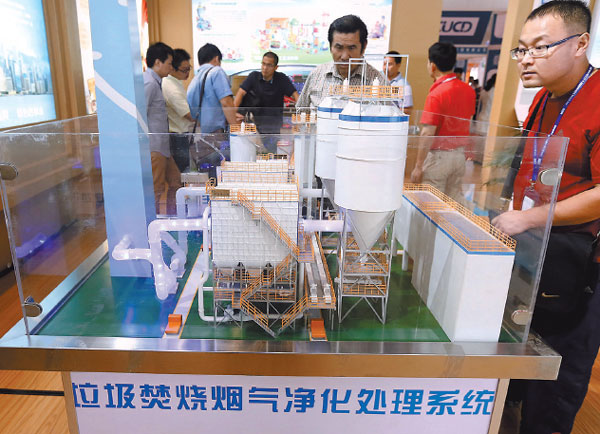3 more incinerators to burn mounting waste
 0 Comment(s)
0 Comment(s) Print
Print E-mail China Daily, January 29, 2015
E-mail China Daily, January 29, 2015
Beijing will build three more incinerators to triple the daily capacity of dealing with the increasing amount of garbage this year, while deputies suggest that the government improve the waste disposal process to protect the environment and make better use of resources.
 |
|
A scale model of a purification plant that filters emissions from waste disposal incinerators is displayed at an exhibition in Beijing in September. [Photo/China Daily] |
With a population exceeding 21 million, the capital faces a record high of 18,400 metric tons of daily household garbage.
Existing facilities can process around 21,000 tons every day, said Li Rugang, deputy director of the Beijing Commission of City Administration and Environment, the department in charge of waste disposal facilities.
However, only 28 percent of the facilities in Beijing use incineration, which is much lower than the 70 percent in Japan and other developed countries, Li said.
Many landfill sites are becoming full, making the need for additional incinerators more urgent. The waste from the incinerators uses 90 percent less land.
The three new incinerators, to be located in the suburbs, will start trial operation by the end of this year, increasing the daily incinerating capacity to 17,000 tons, a growth of 200 percent compared with last year, Li said.
"Beijing will make incineration the major way to deal with waste, even digging out landfill waste and burning it to protect land resources," the deputy director said.
In addition, waste incineration can generate power. The Lujiashan incinerator, the largest in the world, is expected to generate power of around 4.2 gigawatts annually from heat in the burning process, the equivalent to 140,000 tons of coal.
Though incinerators are cleaner in dealing with garbage, many residents oppose the construction of such plants in their "backyard" for the fear of potential pollution and harm to their health. Some have organized marches against such projects.
"The government should protect the interests of the majority of the people in these cases," said lawyer Wei Aimin. "But we also need to find a solution through the legal process if some insist on unreasonable requests."
Xu Nenxia, a deputy of Beijing People's Congress, said the Lujiashan incinerator is not harmful to the environment and it didn't look as bad as many residents imagined. She visited the incinerator in Beijing's western suburb last year.
Based on official records from the incinerator, Lujiashan's emissions did not exceed the stringent standards of the European Union.
"We don't smell the stinky smells or see dust in the air, but look at the clean yard," Xu said.
She has taken a special interest in waste disposal facilities, and has noticed many illegal refuse landfills in suburbs polluting of the land, water and air.
She submitted a proposal for the government to release guidelines on garbage classification for residents.
"There should be improved management of the waste disposal system, especially for the departments in charge, to make them work for residents and the environment," she said.





